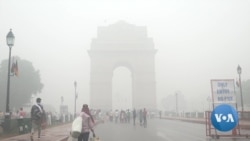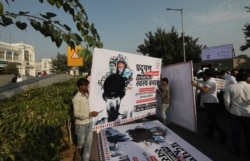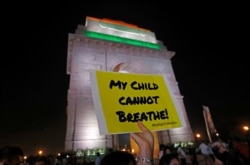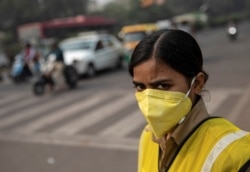NEW DELHI — As winter sets in, residents in New Delhi follow an unusual weather routine: People in the world's most polluted capital do not look out their windows to see whether it is a sunny or a chilly day, but to check on how bad the toxic smog that envelops the city is.
This year, Nandini Guha, 65, did not wait to watch the skies turn gray and city landmarks and buildings virtually disappear under a haze of dirty air. She left the city for a few weeks before air pollution levels hit a three-year high, touching the hazardous category last week.
Earlier this year, medical tests showed that Guha, a former college professor and longtime city resident, had developed asthma. "I already have been put on inhalers and on nasal sprays. I don't want to fall so sick that I have to be hospitalized," she said.
Guha was heeding grim warnings from doctors who advise those who can to leave Delhi in winter, when stagnant winds and cooler temperatures trap the capital and surrounding towns in a cloud of poisonous air, posing a huge health hazard to its 20 million residents.
Hospitals witness an immediate rise in patients visiting emergency rooms, said Dr. Arvind Kumar, chairman of the Center for Chest Surgery at Sir Ganga Ram hospital in New Delhi.
"Breathlessness, acute attacks of asthma, acute pneumonia, especially in young children and the elderly — these are three immediate impacts that we see," he said.
Younger people feel effects
Pointing out that the deadly pollution is literally "blackening" lungs, doctors say the long-term consequences are far more worrying — patients are walking in at a younger age.
"To my mind there is no true nonsmoker in polluted cities, because whether you inhale pollution smoke or cigarette smoke, the effect on your system is the same,” Kumar said. “Both lead to higher incidence of lung diseases, including lung cancer."
For the first time, authorities declared a public health emergency in the city, calling on people to stay indoors if possible. Schools were shut this week. Starting Monday, authorities also introduced car rationing for 12 days in a bid to reduce the smog by allowing those with number plates ending with odd or even numbers out on alternate days.
Environmental experts are urging authorities to take more permanent action to reduce the massive fleet of vehicles that clog city roads by scaling up the woefully inadequate public transport system.
"The transportation sector will require the most disruptive action, because the dependence on personal vehicles has increased," said Anumita Roychowdhury, executive director at the Center for Science and Environment. "The data in Delhi is showing that since 2010, emissions from transport alone have increased by 40 percent."
9 million vehicles
Although pollution is at its worst from November to February, Delhi's air misses clean-air standards by a wide margin for much of the year. It is a noxious mix of emissions from its 9 million vehicles, construction dust and burning of waste. On the worst days, the air quality index, a benchmark ranging from zero (good) to 500 (hazardous), exceeds 400.
When that happened last week, the Supreme Court, in response to a petition by activists, said the choking present in the capital every year "could not be allowed in a civilized country." It ordered neighboring state governments to stop farmers from setting fire to crop stubble, a practice that sends plumes of toxic smoke blowing toward the Indian capital at this time of the year, worsening the air quality.
But the fires are likely to rage on for a few days. Efforts to halt the practice have been largely unsuccessful, with most farmers saying they have no other way of preparing their fields for the next harvest.
As the city struggles to improve its air, doctors are underlining the urgent need to sensitize people about the most dangerous pollutant in Delhi's air, tiny particulate matter known as PM 2.5. Its level on the worst days can surpass 20 times the safe limit set by the World Health Organization.
"There is no point in talking to people about the numbers,” Kumar said. “If you tell them PM is 400, PM is 450, it does not connect with them. But if you tell them that a 28-year-old nonsmoker girl in Delhi has got lung cancer, and it is probably due to air pollution, suddenly people sit up and take notice."
Children's campaigns
Some are heeding the message. Schoolchildren led campaigns urging people to refrain from using firecrackers, which exacerbate the pollution problem, during the Hindu Diwali festival, held this year on Oct. 27. Residents also check pollution apps that show air quality readings on their phones before heading out, and they huddle indoors if possible on the worst days.
Those who can afford it have equipped their homes with air purifiers. The bigger hotels assure guests of measures they have taken to control indoor pollution. Children stop playing outdoors on the days that air quality deteriorates.
For Sudha Marwah's 4-year-old granddaughter, an indoor swing has replaced one in the park. "The maximum what we do is to take her to play in some mall in the play area,” Marwah said. “But we don't expose her to the weather outside."
Several businesses have said they want to relocate because some of their employees want to leave Delhi. But for millions of people, venturing outdoors and braving the city's air is something that can’t be avoided.
For many others, estimates that air pollution kills over 1 million Indians every year have still not hit home. On Sunday, the worst day for pollution this season, many could be seen strolling outside India Gate, New Delhi's landmark monument.











